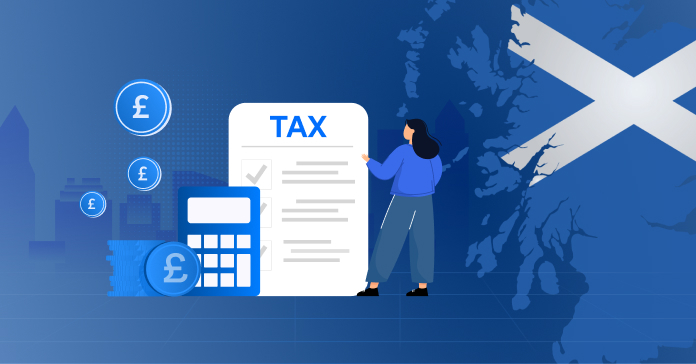If you live in Scotland, you're likely paying different income tax rates than the rest of the UK—and you might not even know it. Scottish income tax has been in place since 2017, creating a unique tax system that affects your take-home pay, tax planning, and business decisions.
Whether you're an employee, business owner, or simply curious about how Scottish tax bands work, this guide breaks down everything you need to know about Scottish income tax rates, how they differ from the rest of the UK, and what it means for your finances.
What is Scottish Income Tax?
Scottish income tax isn't actually a separate tax system. Instead, it's a clever arrangement where the Scottish Parliament has the power to set different income tax rates and bands for Scottish residents.
Here's how it works: if you're classified as a Scottish taxpayer, you'll pay Scottish income tax rates on your employment income, pension, and most other earnings. However, you'll still pay the same UK rates as everyone else on savings interest and dividend income.
The key difference lies in who gets your money. Income tax paid on your wages and pension goes directly to the Scottish Government, while tax on your savings and dividends still goes to the UK Government.
Who Qualifies as a Scottish Taxpayer?
You're considered a Scottish taxpayer if Scotland is your main place of residence. This typically means you spend more than half the tax year in Scotland, but there are specific rules that determine your status.
Your tax allowances—like the personal allowance of £12,570—remain exactly the same as the rest of the UK. Scottish income tax only affects the rates you pay, not the allowances you're entitled to.
Scottish Tax Bands 2024/25: The Complete Breakdown
The Scottish Government sets more tax bands than the rest of the UK, creating what's known as a "progressive" tax system. Here are the current Scottish tax bands for 2024/25:
| Band Name | Income Range | Tax Rate |
| Personal Allowance | Up to £12,570 | 0% |
| Starter Rate | £12,571 to £14,876 | 19% |
| Basic Rate | £14,877 to £26,561 | 20% |
| Intermediate Rate | £26,562 to £43,662 | 21% |
| Higher Rate | £43,663 to £75,000 | 42% |
| Advanced Rate | £75,001 to £125,140 | 45% |
| Top Rate | Over £125,140 | 48% |
What's Changed for 2025/26?
The Scottish tax bands 2025/26 show some adjustments to the band thresholds:
| Band Name | Income Range | Tax Rate |
| Personal Allowance | Up to £12,570 | 0% |
| Starter Rate | £12,571 to £15,397 | 19% |
| Basic Rate | £15,398 to £27,491 | 20% |
| Intermediate Rate | £27,492 to £43,662 | 21% |
| Higher Rate | £43,663 to £75,000 | 42% |
| Advanced Rate | £75,001 to £125,140 | 45% |
| Top Rate | Over £125,140 | 48% |
The main changes include wider starter and basic rate bands, giving some taxpayers a small reduction in their overall tax burden.
How Scottish Tax Rates Compare to the Rest of the UK
Scottish income tax bands create both winners and losers compared to the rest of the UK. Here's where the differences really matter:
Lower earners benefit: The 19% starter rate means those earning between £12,571 and the starter rate threshold pay less tax than their counterparts in England, Wales, and Northern Ireland.
Middle earners pay more: The intermediate rate of 21% kicks in at £26,562 (2024/25), meaning middle-income earners face higher tax rates than the rest of the UK.
Higher earners pay significantly more: The higher rate starts at £43,663 compared to £50,271 in the rest of the UK, and the rate itself is 42% rather than 40%.
How to Avoid Paying 40% Tax in Scotland
Actually, you can't avoid paying 40% tax in Scotland—because the Scottish higher rate is 42%, not 40%. However, there are legitimate ways to reduce your overall tax burden:
Maximise Your Pension Contributions
Contributing to your pension is one of the most effective ways to reduce your taxable income. You'll get tax relief at your marginal rate, which could be 21%, 42%, 45%, or even 48% depending on your income level.
For 2024/25, you can contribute up to £60,000 annually to your pension (including employer contributions) or 100% of your earnings if lower.
Use Your ISA Allowances
While ISAs don't reduce your income tax directly, they shelter your savings from future tax. The annual ISA allowance is £20,000 for 2024/25.
Consider Salary Sacrifice Schemes
If your employer offers salary sacrifice for benefits like cycle-to-work schemes, electric cars, or additional pension contributions, these can reduce your taxable income.
Time Your Income Carefully
If you're self-employed or have control over when you receive income, timing payments across tax years can help manage which tax bands you fall into.
Why Are Scottish Tax Rates So High?
Scottish tax rates aren't necessarily "high" across the board—it depends on your income level. The Scottish Government has chosen to create a more progressive tax system where:
- Lower earners pay less (19% starter rate vs 20% basic rate in rest of UK)
- Middle and higher earners pay more to fund public services
- The additional revenue helps fund Scottish public services
This approach reflects the Scottish Government's policy priorities around public service funding and income redistribution. The extra revenue generated helps fund areas like education, healthcare, and social services that are devolved to Scotland.
How Much Can You Earn Before Paying 42% Tax in Scotland?
In Scotland, you'll start paying the 42% higher rate once your income exceeds £43,662 for both 2024/25 and 2025/26. This is significantly lower than the rest of the UK, where the 40% higher rate doesn't kick in until £50,271.
This means if you earn £50,000 in Scotland, you'll pay:
- 0% on the first £12,570 (personal allowance)
- 19% on £12,571 to £14,876
- 20% on £14,877 to £26,561
- 21% on £26,562 to £43,662
- 42% on £43,663 to £50,000
The same earner in England would pay 20% on income between £12,571 and £50,000, making Scottish residents with this income level worse off.
Salary vs Dividends Strategy
Scottish income tax applies only to employment income, such as salaries and director's remuneration, whereas dividends are taxed at UK-wide rates.
This distinction creates opportunities for strategic tax planning by carefully balancing the split between salary and dividends. By optimising this balance, individuals can potentially reduce their overall tax liability while ensuring compliance with both Scottish and UK tax regulations.
Factors such as personal allowances, tax brackets, and national insurance contributions should be carefully considered to create a tailored approach that maximizes tax efficiency while aligning with long-term financial goals. Consulting a tax professional can help ensure the strategy is both effective and compliant.
Timing of Income Recognition
For sole traders and partnerships, you have some control over when income is recognised. This can help manage which tax bands your income falls into across different tax years.
Employee Considerations
If you employ staff in Scotland, they'll be subject to Scottish income tax rates. This doesn't affect your business directly, but it might influence salary negotiations and employee satisfaction.
Planning for the Future: Scottish Tax Trends
Scottish tax policy continues to evolve. The trend has been towards maintaining or slightly widening the gap between Scottish and UK rates, particularly for higher earners.
Key trends to watch:
- Continued focus on progressive taxation
- Potential adjustments to band thresholds
- Possible changes to align with UK policy or diverge further
How Debitam Can Help Scottish Taxpayers and Businesses
Navigating Scottish tax bands can be complex, especially for business owners who need to balance personal tax efficiency with business needs. Whether you're trying to understand how Scottish tax affects your take-home pay, planning your business structure, or considering expanding into Scotland, getting the tax strategy right is crucial.
At Debitam, we specialise in helping new businesses all around the UK and individuals optimise their tax position. Our team understands the unique challenges of the Scottish tax system and can help you:
- Calculate your exact tax liability under Scottish rates
- Plan your salary and dividend strategy for optimal tax efficiency
- Navigate the differences between Scottish and UK tax rules
- Ensure you're claiming all available allowances and reliefs
- Plan for future tax changes and their impact on your finances
From sole traders just starting out to established businesses expanding across the UK, we provide the expertise you need to make informed decisions about your tax affairs.
Getting your tax strategy right in Scotland isn't just about compliance—it's about maximising your financial efficiency while supporting your business goals. Contact Debitam today to discover how we can help you navigate the Scottish tax landscape with confidence.













